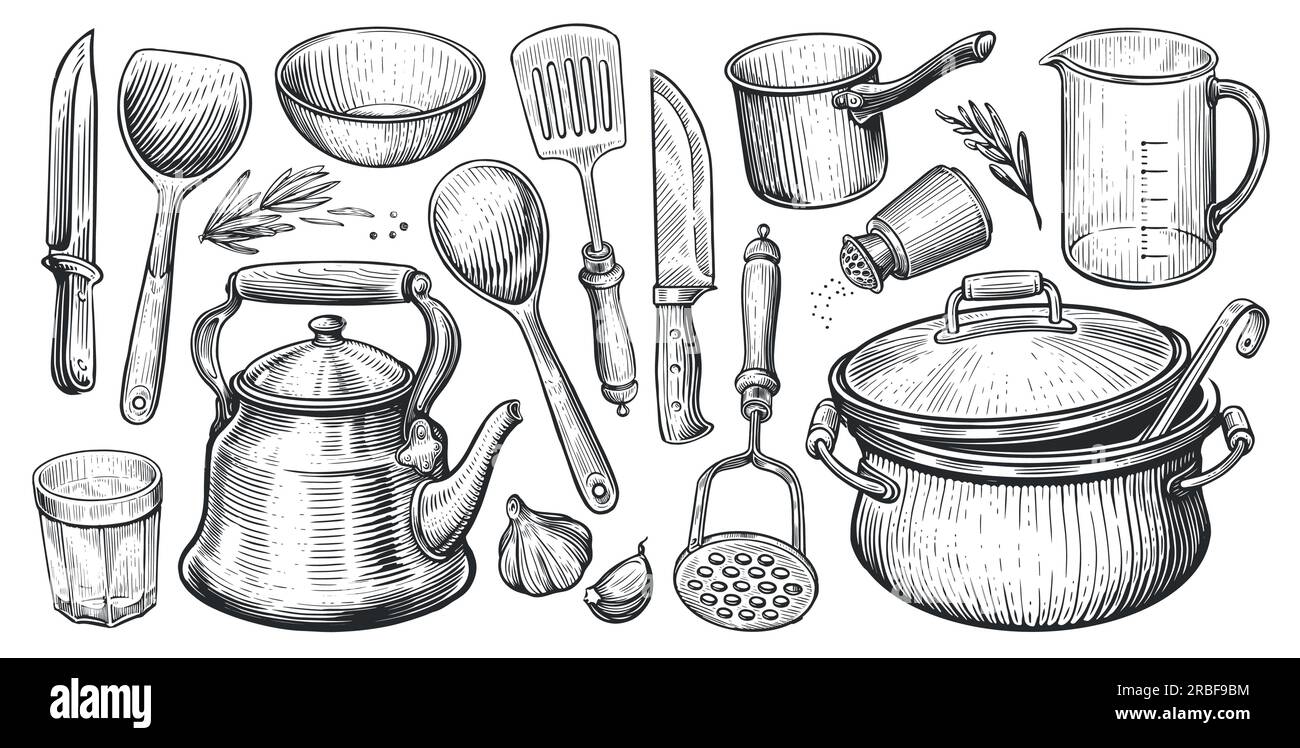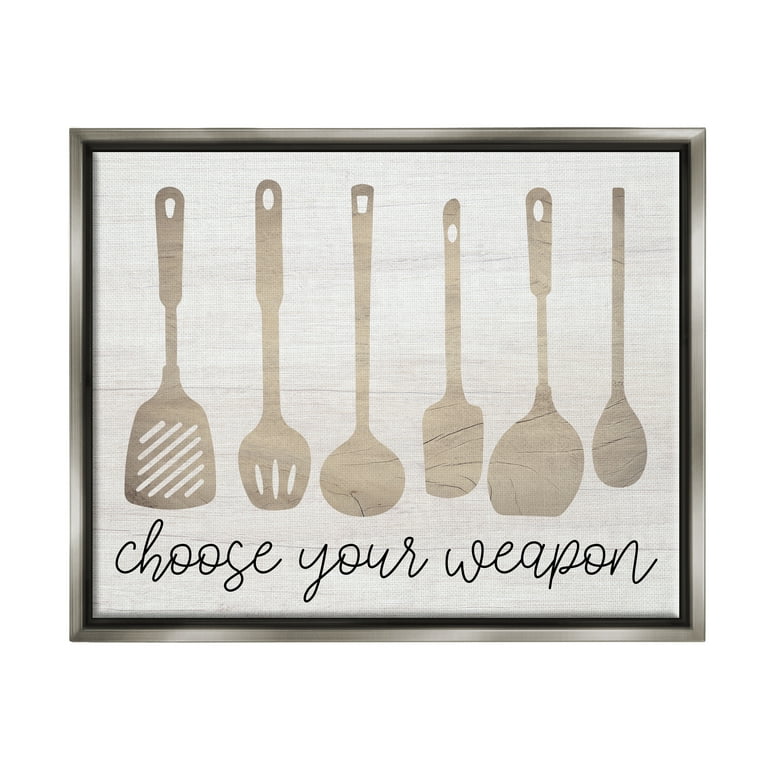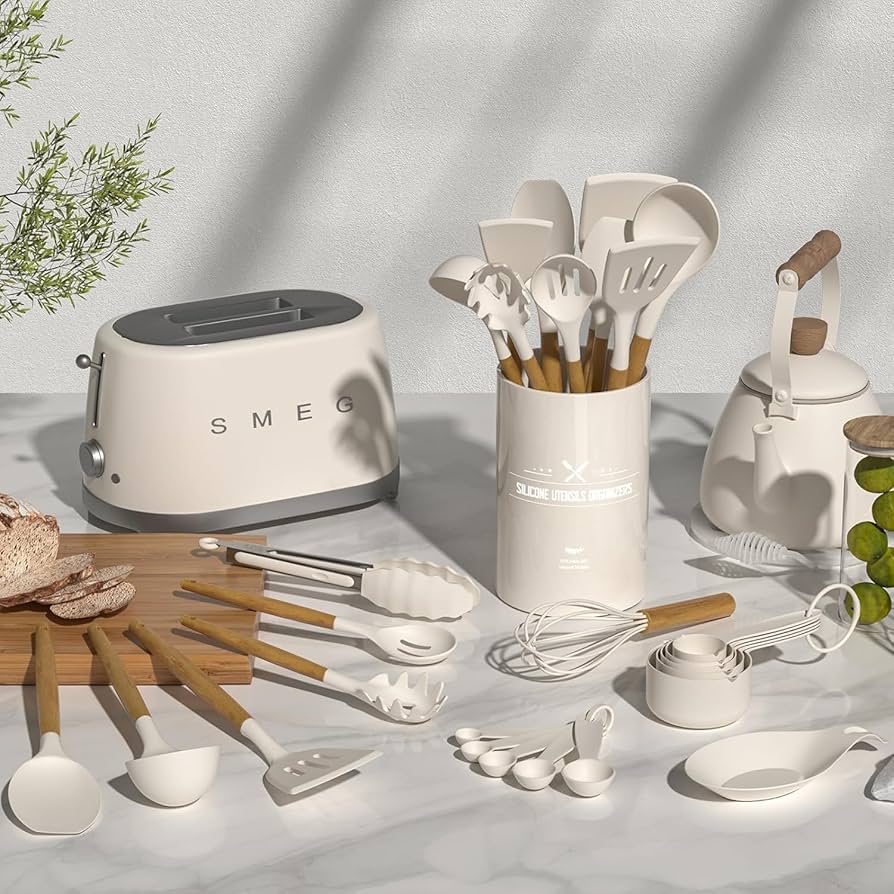As an Amazon Associate I earn from qualifying purchases.
Choosing the right kitchen utensils can transform your cooking experience from a chore into a joy. Imagine slicing through vegetables effortlessly or flipping pancakes without a hitch.
The right tools make all the difference. But with so many options out there, how do you decide which utensils are worth your investment? You might find yourself overwhelmed by the choices, unsure of where to start. The good news is, you’re not alone, and we’re here to help.
By the end of this article, you’ll know exactly what to look for to make your kitchen not just functional, but a pleasure to work in. Let’s dive into the essential tips and tricks for selecting the perfect kitchen utensils for your needs.

Credit: www.amazon.com
Essential Utensils For Every Kitchen
Choosing the right kitchen utensils can transform your cooking experience. Essential utensils make daily tasks easier and more enjoyable. Whether you’re a beginner or an experienced cook, having the right tools is crucial. These utensils help you prepare meals efficiently and effectively. Let’s explore the must-have items for every kitchen.
Basic Tools You Need
Start with a sturdy set of knives. A chef’s knife is versatile for chopping and slicing. A paring knife handles small tasks like peeling fruits. Have a serrated knife for cutting bread effortlessly. Measuring cups and spoons ensure accurate ingredient amounts. Invest in a durable cutting board. It protects your countertop and prevents knife damage.
Get a reliable frying pan. It works for eggs, pancakes, and more. A saucepan is essential for soups and sauces. A baking sheet is perfect for roasting vegetables and baking cookies. Mixing bowls are crucial for combining ingredients. They come in various sizes for different needs. A whisk helps blend liquids smoothly.
Multipurpose Utensils
Consider a spatula for flipping and serving. Choose one that withstands heat. A ladle serves soups and stews with ease. Tongs are great for grilling and tossing salads. A peeler quickly removes fruit and vegetable skins. A grater is useful for cheese, zest, and more. A colander drains pasta and rinses produce.
Get a multipurpose food processor. It chops, slices, and purees ingredients quickly. A hand mixer blends batters and whips cream effortlessly. A rolling pin is vital for dough preparation. A vegetable brush keeps produce clean. A timer keeps track of cooking times accurately. These tools enhance kitchen efficiency.

Credit: www.alamy.com
Material Matters
Choosing the right kitchen utensils can transform your cooking experience. One crucial factor is the material of the utensil. Different materials offer unique benefits and drawbacks. Understanding these can help you make informed decisions for your culinary needs.
Stainless Steel Advantages
Stainless steel utensils are durable and resistant to rust. They can withstand high temperatures without warping or bending. This makes them ideal for cooking and serving hot dishes.
Imagine flipping pancakes without worrying about damaging your spatula. Stainless steel offers this peace of mind. It’s also easy to clean, saving you time and effort.
These utensils are often polished for a sleek, modern look. They add a touch of sophistication to your kitchen. If aesthetics matter to you, stainless steel is a top choice.
Wooden Utensils Benefits
Wooden utensils are gentle on non-stick cookware. They prevent scratching and extend the life of your pots and pans. If you value your cookware, wooden tools are a safe bet.
These utensils have a natural warmth that can make cooking feel more homely. Ever notice how stirring a pot with a wooden spoon feels comforting? It’s a small pleasure that enhances the cooking experience.
Wood doesn’t conduct heat, so handles remain cool even when used in hot dishes. This means fewer burnt fingers. You can cook comfortably without needing to grab a pot holder every time.
Silicone Versatility
Silicone utensils are flexible and can be used with a variety of cookware. They are non-stick, making it easy to scrape every last bit of batter from a bowl. If you like baking, silicone spatulas are a must-have.
They are heat resistant up to high temperatures, ideal for stovetop cooking. You can stir fry without worrying about melting or damaging the tool. This versatility is a practical advantage.
Silicone is available in vibrant colors, adding fun to your kitchen. A pop of color can brighten your day and make cooking more enjoyable. Wouldn’t you love a little extra cheer while preparing meals?
Considering these material options, what suits your kitchen best? Whether you prioritize durability, comfort, or versatility, choosing the right material can enhance your cooking and make it more enjoyable.
Comfort And Ergonomics
Choosing kitchen utensils involves considering comfort and ergonomics. Select utensils with comfortable grips and balanced weight. Prioritize ergonomic designs to reduce strain during use, ensuring a pleasant cooking experience.
Choosing the right kitchen utensils goes beyond just picking what looks good. Comfort and ergonomics play a crucial role in making your cooking experience enjoyable and efficient. Imagine preparing your favorite dish, only to find your hands aching from poorly designed tools. Paying attention to the comfort and ergonomic design of kitchen utensils can make all the difference in both the process and the result of your culinary creations.
Handle Design
When evaluating kitchen utensils, the handle design is a key factor. The best handles are those that fit naturally into your hand, offering a secure and comfortable grip. Consider materials like silicone or rubber, which provide a non-slip surface even when your hands are wet.
Think about the shape of the handle as well. Rounded or contoured handles often feel more natural to hold. They reduce the strain on your fingers and wrists. It’s worth testing a few options in-store to see which feels most comfortable for you.
Weight Considerations
The weight of a utensil can significantly impact your cooking experience. While heavier utensils might feel sturdy, they can quickly become tiring if you’re using them for extended periods. Lighter utensils are generally easier to maneuver, but they should still feel robust enough to withstand regular use.
Consider what you cook most often. If you’re frequently stirring large pots of soup, a slightly heavier spoon might be beneficial. For detailed tasks like peeling or slicing, a lighter tool may offer more precision and control.
Ask yourself: Does this utensil feel like an extension of your hand? If not, it might be worth seeking an alternative. Your comfort in the kitchen is paramount, and the right utensils can make all the difference in your cooking routine.
Durability And Maintenance
Durability and maintenance are key factors when choosing kitchen utensils. You want tools that can withstand daily use and are easy to care for. It’s not just about how they look or perform; it’s also about how long they last and the effort required to keep them in top condition. Think about your busy mornings. Wouldn’t it be great if your utensils could handle your rush without wearing out quickly?
Easy To Clean Options
Cleaning can be a chore, especially after cooking a big meal. Choose utensils that require minimal effort to clean. Look for dishwasher-safe options, or those that can be wiped down effortlessly.
Silicone spatulas and stainless steel whisks are great picks. They don’t retain odors or stains and can be cleaned with a simple rinse. Consider how much time you can save with utensils that are easy to maintain.
Long-lasting Materials
Materials matter for durability. Stainless steel, silicone, and wood are excellent choices. Stainless steel is rust-resistant and sturdy, making it ideal for frequent use.
Silicone, flexible and durable, is perfect for high-heat cooking. It doesn’t melt or warp easily. Wood, while classic and aesthetically pleasing, can last long if properly cared for. What do you want your utensils to withstand?
Next time you’re shopping for kitchen tools, think beyond just their immediate appeal. Consider how much they will simplify your life over time.
Budget-friendly Choices
Choosing kitchen utensils on a budget doesn’t mean sacrificing quality or style. Smart choices can lead to a well-equipped kitchen without breaking the bank. This section explores how to find affordable kitchen tools that fit your needs and maintain quality.
Affordable Finds
Seek out stores offering discounts on kitchenware. Online marketplaces often have deals on utensils. Thrift stores are great spots for finding unique items at low prices. Many affordable brands offer durable kitchen tools that last.
Consider buying sets rather than individual pieces. Sets often provide a better value. Look for multipurpose utensils. These can handle several tasks, saving both money and space. Sales and clearance sections are treasure troves for budget-friendly options.
Quality Vs. Cost
Expensive doesn’t always mean better. Many low-cost utensils offer high quality. Read reviews before purchasing. Feedback from others helps gauge product durability. Opt for utensils made from sturdy materials. Stainless steel and silicone are good choices.
Invest in items used frequently. Spend wisely on essentials like knives and pans. For less-used items, a lower price might suffice. Balance your budget by prioritizing quality in key areas. This approach ensures both cost-efficiency and satisfaction.
Eco-friendly Alternatives
Opt for bamboo, stainless steel, or silicone utensils to minimize environmental impact. These materials are durable and biodegradable. Prioritize products with minimal packaging to further reduce waste.
Choosing kitchen utensils that are environmentally friendly doesn’t just help the planet; it also brings a touch of nature into your home. Eco-friendly alternatives are gaining popularity as more people become aware of their impact on the environment. If you’re looking to make sustainable choices in your kitchen, here are some options to consider.
Sustainable Materials
When selecting utensils, look for those made from sustainable materials like bamboo, wood, or stainless steel. Bamboo is fast-growing and renewable, making it an excellent choice for spoons and spatulas. Wood provides durability and a rustic charm but ensure it’s sourced responsibly.
Stainless steel is long-lasting and can be recycled, reducing waste. It’s perfect for items like knives and ladles. By choosing sustainable materials, you support eco-friendly production practices. Have you ever thought about how your choice of a simple spoon can make a difference?
Recyclable Options
Consider utensils that are easily recyclable at the end of their life. Metal utensils, for instance, can often be recycled, unlike plastic ones that end up in landfills. Glass is another recyclable option, though less common for everyday utensils.
Check for recycling symbols on products before buying. This small step ensures you contribute to a circular economy. Have you noticed how much packaging you throw away after shopping? Being mindful of recyclable options can significantly reduce that waste.
By opting for eco-friendly utensils, you’re not just making a purchase—you’re making a statement about the kind of world you want to live in. Every choice counts, and your kitchen is a great place to start.
Safety Considerations
Choosing the right kitchen utensils isn’t just about style or efficiency; it’s also about ensuring safety. In a space where heat, sharp edges, and various materials coexist, taking safety into account can prevent accidents and keep your cooking experience enjoyable. Have you ever grabbed a spatula only to discover it’s warped or melted from heat exposure? Or found your favorite non-stick pan shedding particles? These moments remind us why safety considerations are crucial. Let’s dive into key safety aspects you should focus on when selecting kitchen utensils.
Heat Resistance
Heat resistance is more than just a fancy feature; it’s a necessity. Imagine cooking a big family dinner, only to have your spatula melt into your stir-fry. You can avoid this by choosing utensils made from materials like silicone or stainless steel, which are known for their heat-resistant properties. Always check the manufacturer’s specifications for maximum temperature limits to ensure your utensils can handle the heat without compromising their integrity.
Consider your cooking habits, too. If you frequently grill or bake, prioritize utensils that can withstand high temperatures. It’s a small detail that can make a big difference in both safety and longevity of your kitchen tools.
Non-toxic Materials
Non-toxic materials are essential for healthy cooking. Your utensils should be free from harmful chemicals like BPA, which can leach into food. Do some research on the materials used in your kitchen tools. Opt for stainless steel, bamboo, or glass, which are safer and often more durable.
Pay close attention to the labeling. Look for certifications or guarantees from the manufacturer about the absence of toxic substances. This ensures that you’re not only cooking delicious meals but also keeping your loved ones safe. Have you ever thought about what’s in your cookware? It’s worth considering the potential health implications of the materials you’re using.
Ultimately, choosing safe kitchen utensils is about making informed decisions that prioritize both your health and cooking experience. What are some safety features you look for in your kitchen tools?
Storage Solutions
Choosing the right kitchen utensils is only half the battle; figuring out how to store them effectively can make all the difference in keeping your kitchen neat and efficient. With the right storage solutions, you can make the most of your space, keep your utensils organized, and ensure that everything is easy to find when you need it. Here, we dive into some practical ideas for making the most of your kitchen space.
Space-saving Ideas
Is your kitchen feeling cramped? You might be surprised at how much space you can free up with a few clever tricks. Consider using wall-mounted racks for items like pots and pans. This frees up cabinet space and keeps your most-used items within easy reach.
Don’t forget about vertical storage! Tall, narrow shelves or pegboards can be installed to hold utensils or spices, utilizing otherwise wasted wall space. Utilizing vertical space not only adds storage but can also add a stylish touch to your kitchen.
Think about drawer dividers for organizing your utensils. They come in various sizes and can be customized to fit the specific needs of your kitchen. This keeps everything in its place and prevents items from getting tangled together.
Organizational Tips
Organization is key to a functional kitchen. Start by grouping similar items together. This makes it easier to find what you need and speeds up cooking time. For example, keep all baking utensils in one drawer or basket.
Consider labeling your storage containers. This might sound unnecessary, but when you’re in a rush, you’ll appreciate the clarity it provides. Labels can be easily updated, so don’t worry if your needs change over time.
Think about the flow of your kitchen. Place frequently used items in easy-to-access spots. If you cook daily, make sure essential utensils are stored at the front of drawers or shelves. This reduces unnecessary movement and keeps your cooking process smooth.
Have you ever spent too long looking for that one elusive spatula or whisk? By implementing these storage solutions, you could transform your kitchen into a streamlined space where cooking becomes a pleasure rather than a chore. What storage solution works best for your kitchen setup?
Expert Recommendations
Choosing kitchen utensils involves considering durability, material, and versatility. Stainless steel offers strength and longevity. Silicone is flexible and heat-resistant.
Choosing the right kitchen utensils can feel overwhelming with all the options available. Expert recommendations can help you make informed choices. With insights from seasoned chefs and industry leaders, you can equip your kitchen with tools that enhance your culinary experience.
Chef-approved Picks
When selecting kitchen utensils, consider what professionals use. Chefs often recommend high-quality knives, as they are a staple in every kitchen. A sturdy chef’s knife can make chopping vegetables or slicing meat easier and more precise.
Another chef favorite is the cast-iron skillet. It offers durability and even heat distribution for various cooking methods. It may require some maintenance, but the results are worth it. Do you have a skillet that has been in the family for generations?
Popular Brands
Certain brands stand out in the world of kitchen utensils. OXO, for example, is known for its comfortable grips and user-friendly designs. Their peelers and spatulas are often praised for their functionality.
Le Creuset offers vibrant and durable cookware that can add a pop of color to your kitchen. Their Dutch ovens are particularly popular for slow-cooking dishes. Which brand do you trust most in your kitchen?
Incorporating expert advice into your utensil selection can transform your cooking experience. Next time you’re shopping, consider these recommendations to elevate your culinary skills.

Credit: www.walmart.com
Frequently Asked Questions
How To Choose Cooking Utensils?
Choose durable materials like stainless steel or silicone. Select utensils that fit your cooking style and needs. Ensure they are heat-resistant and easy to clean. Consider ergonomic designs for comfort and safety. Match utensils with your cookware to prevent scratching or damage.
What Utensils Should Every Kitchen Have?
Every kitchen needs essential utensils like knives, cutting board, pots, pans, mixing bowls, and measuring cups. Include spatula, whisk, tongs, and colander for versatile cooking. Ensure quality and durability for long-lasting use. These tools streamline cooking and enhance culinary skills efficiently.
Optimize your kitchen with these must-have items.
What Are The 5 Main Categories Of Kitchen Utensils?
The five main categories of kitchen utensils are cutting tools, measuring tools, mixing tools, cooking tools, and serving tools. These categories encompass essential items like knives, measuring cups, mixing bowls, spatulas, and serving spoons. Each category plays a vital role in efficient kitchen operations.
What Is The Best Material For Kitchen Utensils?
Stainless steel is the best material for kitchen utensils. It is durable, rust-resistant, and easy to clean. Stainless steel utensils are safe for food preparation and cooking. This material ensures longevity and maintains its appearance over time. Its non-reactive nature makes it ideal for various cooking tasks.
Conclusion
Choosing kitchen utensils wisely enhances your cooking experience. Focus on quality and durability. Stainless steel and silicone are great options. Consider your cooking style and needs. Look for utensils that fit comfortably in your hand. Prioritize easy-to-clean items. Ensure they match your kitchen decor.
Avoid clutter; select versatile tools. Remember, good utensils make a difference. They streamline meal preparation. Invest in pieces you’ll use often. Take your time to explore options. Make informed decisions based on preferences. Happy cooking! Enjoy the process and outcomes.
Let your kitchen be a place of joy.
As an Amazon Associate I earn from qualifying purchases.

Sohel Rana is a seasoned author whose passion for home and kitchen essentials permeates through his writing. Born and raised in a small town nestled amidst lush greenery, Rana’s fascination with the intricacies of domestic life blossomed from an early age. His upbringing in a close-knit family environment instilled in him a deep appreciation for the importance of a well-equipped kitchen and a cozy home

